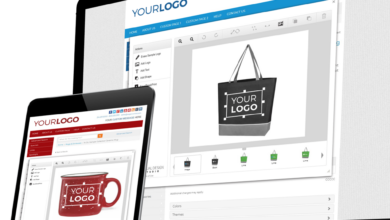The choice of graphics software is usually quite personal. It’s often a matter of how you like to work. Of course, there are other considerations beyond personal preferences too. For example, the style and general look of the project, its purpose and destination, and the capabilities of the software.
Raster or vector: There are two basic systems for generating artwork on a computer. Raster software displays a grid of pixels whose colors can be manipulated using the tools and commands inherent in the program. Raster images are commonly used for photographs and digital art. Adobe Photoshop and Corel PaintShop Pro are the most popular packages for this type of work.
Vector software is quite different in its methodology. Adobe Illustrator and CorelDraw are the mainstream packages employed in the graphics, printing, and technical illustration industries. Vector software uses mathematically defined points, segments, and curves to define the shape and position of objects. An object can be filled with a solid color, a gradient, or a pattern and stroked with a colored outline of a specific weight. Vector images are frequently used for logos, illustrations, cutaways, and graphic design. (Fig. 1)

Fig. 2B: Connecting points and closing the path, produces a polygon with a specific number of sides.
Fig. 2C: A Bezier curve showing the anchor points, segment, and direction handles.
Fig. 2D: A curved path can be closed by clicking the original anchor point to produce a shape. The object needs to be stroked and/or filled to be visible when printed.
Resolution: When a raster image is scaled, the software adds or removes pixels which can result in a loss of quality and sharpness. Vector images, on the other hand, are resolution independent and can be resized without losing quality.
File sizes: One advantage of using vector software is that it produces smaller file sizes compared to raster images. Vector files store mathematic equations that describe the shapes and colors, rather than storing individual pixel data.
Practice: Learning vector software techniques, however, can be a bit challenging. Creating and editing shapes requires hand-eye coordination and practice with the various path generating and editing tools. You’ll find, at first, the techniques are strange; sort of like dragging wet spaghetti onto thin air. In a reasonable amount of time however, the techniques become second-nature.
Paths: The simplest vector object is a single path consisting of two anchor points and a segment (Fig. 2A). An anchor point is deposited on the digital artboard with the click of a mouse or stylus. The mouse or stylus is moved and then another point is deposited. The two points are automatically connected with a path.
If the mouse or stylus is moved and clicked again, another path appears. This process can continue until the path is closed by clicking on the original point (Fig. 2B). This process produces a polygon with a specific number of sides.
Bezier curves: When a point is deposited and the mouse remains depressed and is dragged, a direction handle is created (Fig. 2C). Move the mouse again, click and drag, and a curved path is created. As with straight paths, a curved path can be closed by clicking on the original anchor point creating a shape. The path or shape must be filled or stroked to be visible when printed (Fig. 2D).
Interchangeable: Though raster software is primarily used for pixel manipulation, the Tools panels in both Photoshop and PaintshopPro contain vector tools (Fig. 3).
Vector software features: The path generating tools, of which there are several, are used for drawing and stacking objects that are the key components of illustrations. These basic tools’ primary purpose is to create objects by depositing or manipulating points and line segments. The list of vector tools contains many items that modify paths in very specific ways making drawing quite an adventure. Fig. 4, for example, has been modified with the Twirl tool.
Editability: Since vectors are based on mathematical equations, smooth lines and shapes are easy to generate, making the software ideal for designs that require precise, clean lines.
Typography: Vector software is ideal for illustrators and graphic designers who work with type because typographical characters are actually vector objects. When printed, they produce razor-sharp edges with no “jaggies” (stair-step edges caused by a series of right angles trying to represent a curve), no matter what the resolution of the document. Vector software contains several tools that can
arc, warp, twist, or otherwise modify letter-
forms. (Fig. 5)
Raster-vector objects: Both Adobe Illustrator and CorelDraw have several filters and effects that modify pixels. Applying special features from the Effects menu creates a hybrid object: i.e. an object with both raster and vector properties. A drop shadow, or a Gaussian blur, for example, share characteristics of both raster and vector objects (Fig. 6).
A shape is generated with one of the Pen or Shape tools and edited with a variety of shape altering tools and commands that directly bend the Bezier curves to the will of the artist. By dragging an anchor point, direction handle or segment, the shape can be modified.
Some features perform alterations that convert the shape into a temporary unexpanded state. The unexpanded state is a kind of a hybrid vector-raster object. For example, Illustrator’s Envelope Distortion feature (Object > Envelope Distort > Make with Mesh) creates a distortion grid that can be modified with the Direct Selection tool. (Fig. 7). Dragging points or lines on the grid distort areas on the object. The paths that normally encircle the object are not visible during this process until the object is expanded (Object > Expand), when it returns to its vector status with reshaped Bezier curves.
Industries: Vector-based image software has a wide range of uses across various industries and creative fields due to its scalability, precision, and versatility. It is widely used in graphic design for creating logos, icons, typography, posters, flyers, and other marketing materials. Designers appreciate the ability to scale artwork without loss of quality.










